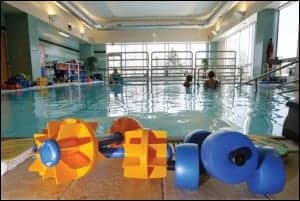 |
Physical and occupational therapists are energetically expanding their practices by adopting fitness/wellness programs—into which many of their rehabilitation clients progress after recovery. Offerings are shaped to fit the local client demographics’ needs, and proprietors often reach out to the community to usher new participants through the wellness door. Rehab Management has tapped the expertise of therapists nationwide and shares their winning strategies.
ROCKETING TO INNER SPACE
Key is determining if enough space exists to operate a wellness program that won’t interfere with the primary practice. CATZ-Competitive Athlete Training Zone, Pasadena, Calif, introduced their program in an overall 2,500-square-foot space, with some 1,000 square feet of open space allotted for the program. Now they operate from a 14,000-square-foot facility, which has ample open space to cultivate clients’ wellness goals. “A physical therapy practice with a bevy of private treatment rooms but scant open space could find the prospect daunting, but space division can be revised, and 500 square feet of open space is sufficient,” says Kevin Wentz, PT, cofounder of CATZ.
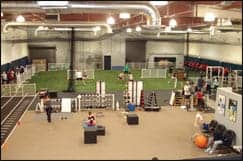 |
| Active people of all ages engage with equipment and each other in fitness activities at CATZ-Competitive Athlete Training Zone, Pasadena, Calif. |
At ACAC-Downtown, Charlottesville, Va, physical therapists transition therapy clients into fitness and wellness programs at a companion health club. Physical Therapy@ACAC (www.acacpt.com) is housed within the ACAC Fitness and Wellness Center (www.acac.com). Technically a separate company, the physical therapy unit is partly owned by the health club and partly by a local hospital system, says Amy Boyer, PT, ATC, clinic manager for physical therapy. “It’s an unbelievable relationship that we have,” says Boyer. “We have full access to our health clubs.”
A gym area located in the physical therapy clinic houses the basic necessities—a treadmill, various pieces of equipment, bikes, hand weights, and some balance equipment, says Boyer. The club’s fitness floors avail participants of a wealth of cardio equipment: a walking/running track, a range of free weight and weight machines, and three pools. Pilates is not among the physical therapy services, but on the fitness/wellness side of the club, several Pilates classes are offered. Fitness/wellness offerings also include the following classes: aquatic exercise, step, body pump (cardio plus weight training), boxing, and spinning. “And we have our mind/body area, which offers Pilates, yoga, and Nia,” says Boyer, noting that the majority of classes are taught by fitness specialists on the club side.
Client demographics run the gamut. Boyer says ACAC’s goal is capturing the “interested deconditioned—those who would like to exercise, know they need to exercise, but just don’t quite know how to do it.” She says the key is making the fitness/wellness facility welcoming. “It can be extremely overwhelming for someone to walk into a gym where they see people lifting heavy weights and everyone’s in tight clothes, and there are many machines and noises,” she says. ACAC woos newcomers with HealthQuest, an area carved out for novices. “It has a little bit of cardio, a little bit of weights, we set up some couches, tables with magazines,” says Boyer. “We always have a fitness specialist in that area to help clients progress with their exercises.” Many new clients and members begin slowly and progress from there.
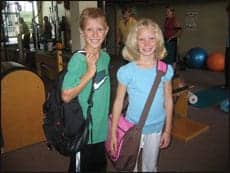 |
| As part of a public service and outreach campaign for adults and children, Inspired Wellness, Birmingham, Ala, participates in National Backpack Awareness Month (September), offering ergonomic workshops and promotional backpacks. |
TAPPING INTO THE SOURCE
Sizing up and tapping into the occupational/physical therapy practice’s existing client base can help spur the transition into wellness offerings: is it heavily weighted toward seniors, patients with hip and/or knee replacements, young athletes, busy professionals, or active middle-aged clients? “The clients are supporting the practice from a therapy standpoint, and now you are going to take them from rehabilitation into a health and wellness program,” says Jim Liston, MEd, CSCS, president and cofounder of CATZ, adding that the practice is essentially expanding its services to satisfy existing clientele and, hopefully, expanding from there. He says people seek three essential features from a wellness program, and the triple threat is key for long-term client retention rates and commitment: they need to get results, there must be camaraderie and social support, and it must be fun.
The rehabilitation philosophy at CATZ attracts active people, not necessarily athletes, but people of all ages who are on the go—such as a 40-year-old marathoner or a 14-year-old volleyball player. “The fitness/wellness program segues rehab clients into readiness and enhanced performance for the sport or activity,” says Wentz. Equipment includes dumbbells and medicine balls—basically, boxes, bells, and balls, says Liston, adding that the ample open space facilitates coordination and motor development. A favorite piece of equipment is the stepmill with moving steps, which used to be called the gauntlet. The facility offers treadmills and bikes, and new equipment is always being added, such as SandBells, a marriage between a dumbbell and a medicine ball.
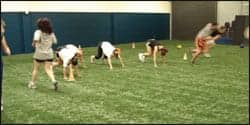 |
| CATZ therapists and trainers customize groundbased activities for small, interactive groups of clients priming for sports activities. |
Popular small-group training sessions taught by four full-time “coaches” (as the instructors have been dubbed) and four part-time coaches at CATZ attract groups of two to 30 clients. (Class schedules are posted at www.catzsports.com.) Many group exercises are full-body, tri-planar, and ground-based activities. Exercises are tailored to meet participants’ needs; among attendees are soccer and baseball players, and a sizeable adult-fitness clientele. Sessions include a 90-minute adult performance class—not for the faint-of-heart, says Liston; a popular 1-hour adult fitness class; and adult fundamentals, which features a slower tempo and more instruction.
ACAC’s fitness and wellness program is enhanced by the PREP (physician referred exercise program) option, whose referrals are from physicians and physical therapists. “We treat our patients in physical therapy, but they need to keep going,” Boyer says. “Where are they going to go, what are they going to do? We transition them into our PREP program.” Clients are given a 2-month membership at the club, where they can meet with a fitness specialist twice a week, and receive a pass to meet with a nutritionist, as well as a pass for a 30-minute massage. “It’s a great transition from physical therapy into health and wellness,” says Boyer.
Inspired Wellness (www.inspiredwell.com), Birmingham, Mich, offers two tracks—rehab, which features the services of an occupational therapist and a physical therapist, and fitness/wellness. “Someone might come in for fitness, but playing tennis they sustain an injury. They decide, ‘I’m having such a great experience for fitness purposes, I want to go there for my rehab,’ ” says Kelly Hale, MS, OTR, founder and director. The practitioners are always updating techniques and modalities—among them, methods for pre- and post-natal care. “We have a multidisciplinary approach,” says Hale. “We’ve got the OT and PT making up the rehab team, and we also have a nutritionist on the team, a muscle-activation practitioner, and a craniosacral therapist.”
The facility houses treadmills, bikes, an upper body ergometer, an elliptical crosstrainer, and Pilates apparatus—Reformers, Trapeze Table, Cadillacs, and more. “We find, in our setting, that those are the most noticeable and intriguing, as people often haven’t seen them before,” says Hale of the Pilates line, adding that “new toys” include BOSU and body-rolling types of equipment.
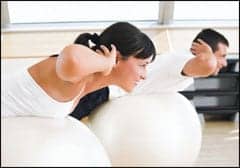 |
| More therapy facilities across the nation are expanding their programs to include physical therapy and health and wellness. |
CREATING A BUZZ
The process of setting up and operating a fitness/wellness program springs from meeting clients’ needs, Hale says. “When we set up the facility, we had to think about how we could best serve people,” she says. “And we do constantly keep the idea of how to best serve in everyday practice too.” The clinic radiates a soothing yet uplifting atmosphere, she says. Hale taps techniques and modalities that deliver efficient results, which are comfortable and accessible for a wide variety of people. Eschewing hot packs and ultrasound, Inspired Wellness offers an infrared sauna as its heat modality.
Hale says the draw in part is that the facility offers holistic modalities, such as Pilates, integrative manual therapy, Brain Gym, the Franklin Method, and Yamuna Body Rolling. The techniques empower clients round-the-clock, “so not only are they getting better when they’re here, but when they’re on their own out in the world or at home, they have tools and techniques to help themselves,” she says.
Elements Fitness & Wellness Center, Washington, DC, originally offered GYROTONIC® Methodology and Pilates. The Gyrotonic method(s) (www.gyrotonic.com) stretches and strengthens muscles, and stimulates and strengthens connective tissues in and around the joints. “Down the road, our Gyrotonic practice expanded tremendously, and we got rid of the Pilates equipment and we just have Pilates mats by request,” says owner Justine Bernard, PT, DPT. “We have a lot of interest in Gyrotonic exercise, so we knew we wanted to offer that, both for the clients and for the teachers.” Bernard employs the devices for therapeutic exercise. Elements (www.elementscenter.com) has seven units of the main piece, called the pulley tower, which exerts constant yet smooth resistance for users, and four other types of the costly equipment. “We wanted a complete system, and we wanted to make sure people walk away with a good understanding of the Gyrotonic method, which is really the whole system, and not just one piece,” says Bernard, who studied with Juliu Horvath, creator of the equipment and exercises. Participants in the GYROKINESIS® class—which accommodates up to 15—use stools for support, and no other equipment.
Exercise bands are among the other pieces of equipment on hand, and services include standard physical therapy exercises, craniosacral therapy, and different types of bodywork. “We tend to not use too many modalities, such as ultrasound and that type of equipment,” says Bernard. “I find one-on-one and hands-on manual skills more important and more effective.”
Elements has two physical therapists and 10 certified Gyrotonic teachers on staff. The facility is situated in a middle- to upper-level-income community, and its group exercise classes attract clients from diverse socioeconomic means and ages from 9 to 90. Some fitness clients get reimbursed for services through flexible-spending account dollars and/or through their insurance plan.
 |
 |
 |
| Shown in this series of photographs: Morgan Fredrick, an instructor at Elements Fitness & Wellness Center, Washington, DC, who is also a dancer with the Washington Ballet, performs the arch and curl, part of the essential movements of the Gyrotonic method. (Photo credit: Marnie Deacon) | ||
GOOD DEEDS YIELD GOOD EXPOSURE
The fitness/wellness niche can be a profitable enterprise for physical and occupational therapists, showcasing the business in a new light within the community. “Therapists are respected as licensed medical professionals who engender trust,” Liston says. CATZ’s best advertising is word-of-mouth and free T-shirts, he says. The facility’s coaches visit local schools, and the facility conducts a sports elective at a local middle school. DPT students from the University of Southern California assist with physical education classes in some local schools and in the facility, with the seniors’ program. A motivator for kids who train at CATZ is a progressive, five-level T-shirt program, akin to the belt system in karate. The ultimate prize is the gold shirt. To get it, youngsters must perform 25 hours of community service, such as helping Liston perform evaluations for under-10 and under-12 soccer players, or helping to lead warm-ups and record athletes’ times—sometimes even acting as assistant coaches for youth sports teams. “That’s what we’re looking for at the highest level, getting our own athletes, our young athletes, out there into the community as well,” says Liston.
ACAC also has the outreach angle covered. Representatives from the club or Physical Therapy@ACAC attend many community events. Charlottesville is a big running town, and the Women’s Four Miler is a popular annual event. “One of our fitness specialists usually leads a warm-up before the race,” says Boyer. “And on the back end, Physical Therapy@ACAC is there on the finish line to help the medical staff with any needs that may arise from the race.” And the facility’s owner donates the majority of old equipment to high school weight rooms, she says.
Many Inspired Wellness clients are seasonal residents due to Michigan’s cold winters. Consistency and results may be lost when they depart for warmer climes. “That’s a real consideration when it comes to scheduling and what services you offer,” says Hale. “We feel we have a responsibility to help those clients or patients find services wherever they go for the winter and make sure they have a really fantastic home program—or we use our large network of professionals to help them find someone in their area to pick up where they’ve been.”
She says clients graduate from a rehab program to wellness/fitness, which supports them and serves as a bridge to a functional, full life. Catering to clients’ oft jam-packed work schedules fuels Hale’s creativity. “We’re here some mornings at 5:30 to service people before work,” she says. “And sometimes we’re here as late as 7, 8 at night. We have a lot of very busy professionals, some high-profile professionals, who need those times.”
Public service offerings show off the facility’s wares—such as a backpack promotion in conjunction with National Backpack Awareness Month. “That brought a lot of young people and students in, and their families as well,” says Hale. “And the families became interested. One person said, ‘I can do fitness here and my brother needs rehab. Let’s talk to him about this place because it’s so unique.’ “Workshops on core, posture, ergonomics, gardening, and golf also attract potential new clients.
Elements’ client list has grown from word of mouth, and from visibility at myriad neighborhood activities, such as the popular Glover Park Day festival. Bernard is trying to attract more veterans by offering discounts to military families.
And the former professional dancer is also trying to draw creative souls—providing discounts to artists, primarily dancers, and to students.
Judy O’Rourke is the associate editor of Rehab Management. For more information, contact .



